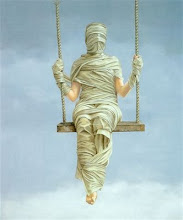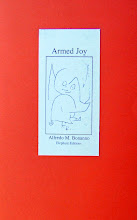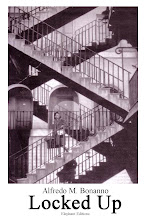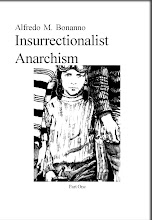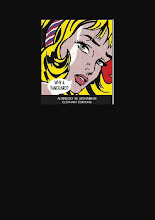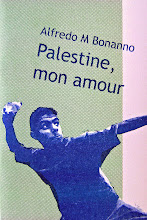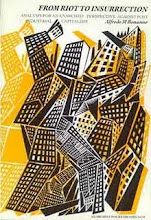The building of the wall that will finally separate the included from the excluded is already in course. It is based on various elements. One of the most important is a diversity of language which is being realised through a reduction in the excluded’s possibility to express themselves.
One of the projects that capital is putting into effect is the reduction of language. By language we mean all forms of expression, particularly those that allow us to articulate complex concepts about feelings and things.
Power needs this reduction because it is replacing straightforward repression with control, where consensus plays a fundamental part. And uniform consensus is impossible where multiform creativity exists.
The old revolutionary problem of propaganda has also changed considerably in recent years, showing up the limitations of a realism that claimed to clealry show the distortions of the world to the exploited, thus putting them in the condition to become conscious of their situation.
Still in the historical sphere of anarchism, we have the quite exceptional example of Malatesta’s literary capacity based on a language that was essentialised to the maximum degree and which constituted a model that was unique for its time. Malatesta did not use rhetoric or shock effects but elementary deductive logic, starting off from simple points based on common sense and reaching complex conclusions that were easily understood by the reader.
Galleani worked at quite a different level. He used great rhetorical constructions, attaching a great deal of importance to the musicality of the phrase as well as to the use of out-dated words chosen to create an atmosphere that in his opinion would move spirits to action.
Neither of the above examples can be proposed as examples of a revolutionary language fit for the present time. Not Malatesta, because there is less to “demonstrate” today, nor Galleani, because there are fewer and fewer spirits to be “moved”.
Perhaps there are more models of revolutionary literature to be found in France, due to that country’s great tradition unequalled in Italy, Spain or Britain, and for her particular spirit of language and culture. Around the same period as the Italian examples mentioned above, we have Faure, Grave and Armand for clarity and exposition, while for research and in some aspects rhetoric, there is Libertad and Zo d’Axa.
We should not forget that France already had the example of Proudhon, whose style surprised even the Academy, and later Faure who was considered to be a continuation of this great school along with the methodical, asphyxiating Grave. Self-taught, he was an enthusiastic pupil of Kropotkin. The latter’s French was good and basic precisely because, like Bakunin’s, it was the French of a Russian.
One could go on forever, from the linguistic, literary and journalistic experiments of Libertad, Zo d’Axa and others, as well as their predecessor Coeurderoy. But although they represent some of the best examples of revolutionary journalism, none of these models is valid today.
The fact is that reality has changed, while revolutionaries continue to produce language in the same way, or rather worse. In order to calculate this it is sufficient to compare a leaflet such as the En Dehors by Zo d’Axa with its huge Daumier drawing on one side and his writing on the other, to some of the lapidary leaflets we produce today - looking at our own situation - such as the one we did for the meeting with the comrades from Eastern Europe at Trieste.
But the problem has gone far beyond that. Not only are our privileged interlocutors losing their language, we are losing ours too. And because we must necessarily meet on common ground if we want to communicate, this loss is turning out to be irrecoverable.
This process of generalised flattening is striking all languages, lowering the heterogeneity of expression to the uniformity of the means. The mechanism is more or less the following, and could be compared to television. The increase in quantity (of new items) reduces the time available for the transmission of each one of them. This is leading to a progressive, spontaneous selection of both image and word, so on the one hand these elements are being essentialised, while on the other the quantity of transmittable data is increasing.
The much desired clarity bemoaned by so many generations of revolutionaries desirous to explain reality to the people, has finally been reached in the only way possible: not by making reality clear (something that is impossible in any case), but making clarity real, i.e. showing the reality that has been built by technology.
This is happening to all linguistic expression including desperate attempts to save human activity through art, which also lets past fewer and fewer possibilities. Moreover, this is finding itself having to struggle on two fronts: first, against being swallowed up by the flattening that is turning creativity into uniformity, and second, against the opposite problem, but one which has the same roots, that of the market and its prices.
My old theses on poor art and art as destruction are still close to my heart.
Let us make an example: all language, in that it is an instrument, can be used many ways. It can be used to transmit a code aimed at maintaining or perfecting consensus, or it can be used to stimulate transgression. Music is no exception here, although because of its particular characteristics the road of transgression is even more difficult. Although it seems more direct, it is actually further from reaching it. Rock is music of recuperation and contributed to extinguishing much of the revolutionary energy of the Seventies. According to Nietzsche’s intuition, the same thing happened with the innovation of Wagnerian music at its time. Think of the great thematic and cultural differences that exist between these two kinds of musical production. Wagner had to build a vast cultural edifice and completely discompose the linguistic instrument in order to captivate the revolutionary youth of his time. Today rock has done the same thing on a much wider scale with a cultural effort that is ridiculous in comparison. The massification of music has favoured the work of recuperation.
So one could say that revolutionary action operates in two ways, first according to the instrument, which is undergoing a process of simplification and stripping down, then in the sense of its use, which has become standardised, producing effects that cannot always be reduced to an average that is acceptable to all or nearly all. That happens in so-called literature (poetry, narrative, theatre, etc.) as well as in that restricted microcosm, the revolutionary activity of examining social problems. Whether this takes the form of articles in anarchist papers, or leaflets, pamphlets, books, etc., the risks are fairly similar. The revolutionary is also a product of his time and uses the instruments and occasions it produces.
The possibility of reading about the actual conditions of society and production has diminished, because there is far less to be brought to the surface, and because interpretative instruments have undergone a recession. In a society which was polarised into two distinctly opposing classes, the task of counter-information was to bring the reality of exploitation that the power structure has every interest in hiding, out into the open. This included mechanisms for extracting surplus value, repressive plots, authoritarian distortions of the State and so on. Now capital is becoming increasingly comprehensible in a society that is moving further and further towards a democratic form of management and production based on information technology. This is precisely because it is becoming more important for it to be seen, and less important to discover the methods of exploitation, not necessary to move the massive upheaval of opinion.
Today society needs to be interpreted with cultural instruments that are not only capable of interpreting facts that are not known or have been treated superficially, but also an unconscious conflictuality far from the old extremely visible class conflict. One ends up being drawn into simplistic refusal that is incapable of examining the mechanisms of recuperation, consensus and globalisation. More than documentation we now need active participation, including writing, in what must be a comprehensive project. We cannot limit ourselves to denouncing exploitation we must bring our analyses to within a precise project, which will only become comprehensible during the course of the analysis itself. Documentation and denunciation are no longer enough. We need something more, so long as we still have tongues to speak with, so long as we have not had them cut off.
This new interaction between ways of expressing oneself and one’s project constitutes the strength of this way of using linguistic instruments, but also leads to the discovery of the latter’s limitations. If language has been impoverished, absorbing and adapting to the reductionist tendencies that have been studied and applied by power, this is inevitable.
I have always fought against a kind of detached objectivism in writing aimed at clarifying revolutionary problems. Precisely because it is an instrument, linguistic expression always has a social dimension that is summed up in its style. It is not just “the man” as Buffon says, but “man in a given society”. And it is the style that solves the problem, undoubtedly a difficult one, of supplying along with the indispensable content, the so-called facts of the event and their insertion within a project. If this project is alive and up to the conditions of the conflict, the style could be livened up, but if the style is not suitable or is lost in the illusion of objectivity, it will run the risk of losing itself in a ghostly forest of impressions.
Our language must therefore have a form that is capable of supporting our revolutionary content, with a provocatory thrust capable of violating and upsetting the usual ways of communicating. It must be able to represent the reality we hold in our hearts without allowing ourselves to become wrapped up in a logical sudarium and only understood with great difficulty. The project and the language used to illustrate this must meet and recognise itself in the style used to express it. Without wanting to go to the extreme of this well-worn thesis, we well know now that the instrument constitutes a considerable part of the content.
We must look out for these processes, not let a new practical ideology submerge us in throwaway phrases where there is no relationship between the project and the way of saying it.
So, increasingly wide linguistic impoverishment is reflected in the instruments of communication that we as revolutionaries use. First of all because we are men and women of our time, participants in the reductive cultural processes that characterise it. We are losing instruments as everyone else, is while others are atrophying. And, more important, we are reducing ourselves. This is normal. We need to make more of an effort to obtain better results and acquire a better capacity to resist these reductive projects.
This lowering in stylistic capacity is a consequence of the lowering of content. It is also capable of producing even greater impoverishment, unable to express the essential part of the project that necessarily remains tied to the means of expression. It is therefore not the “genre” that saves the content, but above all the way this content takes form. Some people make out a schema first according to their capabilities and never manage to free themselves from it. They filter all the content they come to possess through this schema, believing it is “their way of expressing themselves”, like having a limp or brown eyes. But it is not like that. Sooner or later one must free oneself from this prison, as from any other, if one wants to give life to what one is communicating.
There are those who choose irony to transmit the urgency they feel, for example. Very well, but irony has its own peculiarity, i.e. it is pleasant, light, a dance, an allusive metaphor. It cannot become a system without becoming repetitive or pathetic like the satirical inserts in the daily papers, or comic strips where one must know beforehand how the story ends otherwise one wouldn’t be able to understand it, like barrack room jokes. In the same way, for inverse reasons, the call of reality - the effort to make reality visible and palpable through communication, starting from the supposition that there can be no immediate fruition from anything that does not seem real - ends up becoming tedious. In fact it is unrealisable, and one gets lost in the continual material need to insist, losing the conceptuality that is at the basis of true communication.
One maxim in the museum of everyday stupidity is that one does not know how to say something, when in fact the problem is really that one does not know what to say. This is not necessarily so. The communication flux is not unidimensional, but multidimensional: not only do we communicate, we also receive communications. And we have in communicating with others is the same as we have in receiving from others. There is also a problem of style in reception. The same difficulties, the same illusions. For example, still limiting ourselves to written language, when we read newspaper articles we can reconstruct the way the writer receives communication from the outside. The style is always the same, we can identify it in the same kind of article, the same mistakes, the same short-circuits. And that is because these incidents and limits are not only elements of style but are the essential components of the writer’s project, of their very life.
We can see that the poorer and more repetitive the incoming communications are, even when they come directly from the reality of events, the more modest our capacity to grasp the articulations. A revolutionary must necessarily cross both the incoming communications and events. Approximation and uncertainty is emerging in word and unfortunately in deed, a low level of ideas that does not do justice either to the complexities of the enemy’s capacity, or to our own revolutionary intentions.
If things were otherwise, socialist realism, with its good working class always ready to mobilise, would have been the only possible solution. The latest aberration dictated by such ignorance and refusal to consider reality differently was the intervention of the good Rumanian miners to re-establish Illiescu’s new order.
Power’s attempts to generalise the flattening of linguistic expression is one of the essential components for building the insurmountable wall between included andexcluded. If we have identified direct, immediate attack as one instrument in the struggle, we must also develop parallel to this an optimal use of the other instruments at our disposition and take, whatever the cost, those we do not possess. The two are inseparable.
[English translation published in Dissonances, Elephant Editions, London]
skip to main |
skip to sidebar

Some writings of Alfredo Maria Bonanno in English, or almost

Alfredo Bonanno was arrested on October 1st 2009 in Greece, accused of concourse in robbery. With him, anarchist comrade Christos Stratigopoulos.
Here are a few translations and part translations of a small portion of Alfredo's writing. This is a work in progress, many of the translations are as yet incomplete. Open links to find more of Alfredo's work.
Alfredo Bonnano Released
Nov. 22 Alfredo Bonnano was sentenced to 4 years imprisonment (which practically means that with the time served so far and the fact that he is over 70years old HE IS RELEASED
Christos Stratigopoulos (who took responsibility for the action)
was sentenced to 8 years and 9 months with the Greek law will probably be released at the end 2011
BY ANY MEANS NECESSARY
LINKS
click on any of these labels to read text
- "Community" sickness
- 1981 - Editorial
- A Critique of Syndicalist Methods
- A few notes on Sacco and Vanzetti
- A few notes on the revolutionary movement in Italy
- A little man in Singapore
- A million jobs
- A question of class
- Affinity
- After Marx autonomy
- Albania Laboratory of Subversion (Introduction)
- Anarchism and the national liberation struggle
- Anarchists and action
- AND WE WILL ALWAYS BE READY TO STORM THE HEAVENS AGAIN (Against amnesty)
- ANTI-INSTITUTIONAL MOVEMENT
- Are we modern?
- Armed Joy
- ARMED STRUGGLE. SOME REFLECTIONS.
- Autonomous base nuclei
- beyond syndicalism
- Beyond workerism
- But what is the imaginary?
- Class War
- Comiso - Organizational document of the self-managed leagues
- Considerations on illegality
- Dissonances (Introduction)
- Elephant Editions 1986
- Excluded and included
- Farewell to claiming
- Feral Revolution (Introduction)
- FICTITIOUS MOVEMENT AND REAL MOVEMENT
- For an Antiauthoritarian Insurrectionist International - Proposal for a debate
- From riot to insurrection
- From the centre to the periphery
- Good technology
- Guerilla Extraordinary
- Habits and idols
- Hegel
- I know who killed chief superintendent Luigi Calabresi
- Illegality
- Illness and capital
- Informal organisation
- Insurrection
- Internationalism
- Introduction to Sabate
- Introduction to Anarchism and Violence
- Introduction to Bratach Dubh English edition of Malatesta's Fra Contadini
- Introduction to Insurrectionalist Anarchism
- Introduction to Strange Victories
- Introduction to The Conquest of Bread
- Involuntary aspects of voluntary work
- Let's destroy work
- LET'S DESTROY WORK. New introduction
- Let's keep our feet on the ground please
- Lightening Conductors and Stand-ins - more shots of non-news
- Lightning Conductors and Stand-ins
- Lightning Conductors and Stand-ins (cont.)
- Locked up
- Looking forward to self-management
- Loss of language
- More on internationalism
- National Liberation Struggle
- nineteen years on
- No more crises
- Non-news about drugs
- Non-news about racism
- Ode to the Uniform
- On Feminism
- One's life on the line
- Order and chaos
- Otto Ruhle (Introductory Note)
- OUR ROLE IN THE PRESENT CONFLICT
- Palestine mon amour
- Pantagruel anarchist review
- Pinelli
- Prison and Prisoners’ Struggles - Introduction
- Propulsive Utopia
- Quality and the factory
- Restructuring Capital and the new democracy
- Revolution - Violence - Antiauthoritarianism
- REVOLUTIONARY VIOLENCE
- Science and the social revolution
- Self-management
- Severino Di Giovanni in Argentina 1923-1931 by Osvaldo Bayer
- Social banditry
- SOME NOTES -
- Space and Capital
- Stirner
- Stop the City? From information to attack
- Strategy and Methods
- Streamlined production
- The "end" of the crisis
- The aesthetics of anarchism
- The anarchist tension
- The area of autonomy and the anarchist movement in Italy
- The armed wing of science
- The Cruise missile base at Comiso can be prevented
- The ethical bank
- The insurrectional project
- THE LANGUAGE OF TECNICS -
- The logic of insurrection
- The moral split
- THE NECESSARY DESTRUCTION -
- The priority of practice
- The refusal of arms
- The revolutionary project
- The revolutionary struggle
- The significance of an insignificant event
- The struggle for self-managed social space
- The tyranny of weakness
- The whole and the part
- The young in a post industrial society
- Theory and action
- Towards anarchist antimilitarism
- TOWARDS THE GENERALISATION OF ARMED STRUGGLE
- TRANSFORMATION IN THE WORLD OF WORK AND SCHOOL -
- TRUTH -
- Unemployment in Italy - How come everything doesn't explode?
- Untitled
- Violence and non-violence
- What are anarchists
- What can we do with anti-fascism?
- Why a vanguard?
- Why Insurrection
- World domination in a few words

